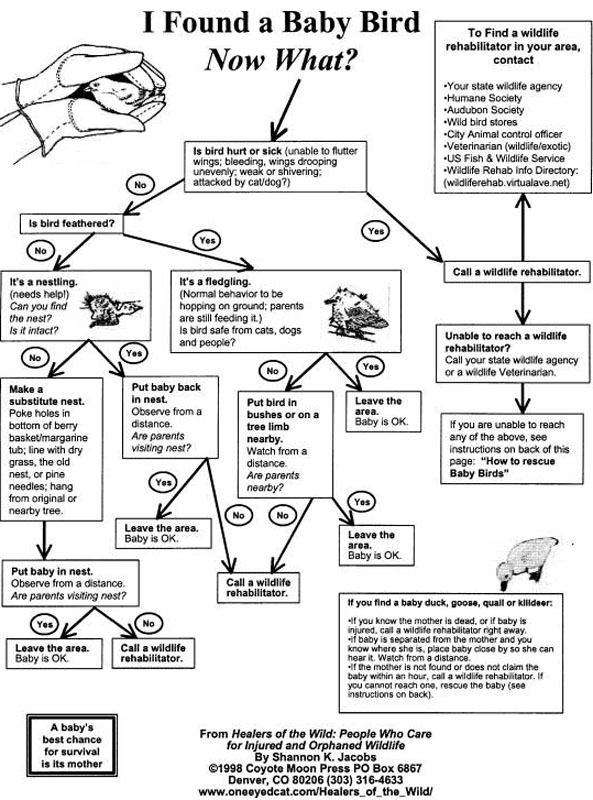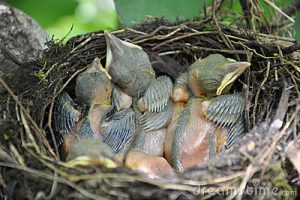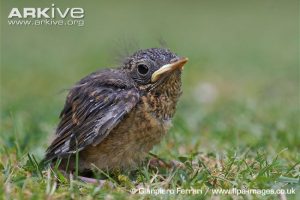 Have you ever heard the saying, if you like wildlife, let it be? I learned this on the first day of my internship at the New England Wildlife Center, and it was emphasized greatly as the number of healthy animals admitted for care increased in the following months.
Have you ever heard the saying, if you like wildlife, let it be? I learned this on the first day of my internship at the New England Wildlife Center, and it was emphasized greatly as the number of healthy animals admitted for care increased in the following months.
Many “orphaned” animals are brought into wildlife clinics every day for the wrong reasons, which drastically decreases their chance of survival. Of course the clinic does everything it can to help, but people are not as efficient at feeding animals compared to the parent.
Clinics receive multiple calls a day about “orphaned” wildlife wondering what they should do. The best answer is to let it be and to observe from a distance unless you are positive the animal is in danger. So how do you know?
Birds:
If you know that the animal is injured (it is bleeding, weak, or you saw it being attacked) or you know for a fact the mother is dead, contact a wildlife rehabber near you. They will most likely tell you to carefully grab the bird (do not chase it), place it in a warm, dry, towel-lined shoebox / box of appropriate size (ensure there are holes in the box for air), and bring it to the clinic for proper care. As with any animal, it is important to do this as calmly and quietly as possible to avoid further stress on the animal. With birds it is important to keep the lid shut so it does not try to fly away.
– – – – – – – – – – – – – – – – – – – – – –
If you believe the bird is orphaned, but are not sure, it is crucial that you do not remove it from that area, but instead observe it from a distance.
The first thing to determine is whether the bird is a nestling or a fledgling:
| Nestlings: | Fledglings: |
|
|
If it is a nestling, keep an eye out for the parent, most likely, they are close by getting food. You can try to find the nest it fell out of and carefully put it back; if you cannot find the original nest, you can make one out of a berry container and put it off the ground close to where you found it. If the parents do not return within two hours, something might be wrong and you should consult a wildlife clinic near you.
If it is a fledgling, let it be. Even though it might seem lost, fledglings are supposed to explore and learn about there surroundings while still depending on the parent for food. If you notice the parent does not return within two hours, something might be wrong and you should consult a wildlife clinic by you.
Here is an easy guide to follow that will help you decide what to do:

Bunnies:
If you know that the animal is injured (it is bleeding, weak, or you saw it being attacked) or you know for a fact the mother is dead, contact a wildlife rehabber near you. They will most likely tell you to carefully grab the bunny (do not chase it), place it in a warm, dry, towel-lined shoebox / box of appropriate size (ensure there are holes in the box for air), and bring it to the clinic for proper care. As with any animal, it is important to do this as calmly and quietly as possible to avoid further stress on the animal. Bunnies are extremely high stress animals that do not do well in captivity so it is crucial to ensure that their environment is warm, dry, dark, and quiet. Also, bunnies have very sensitive stomachs, so it is important, as with all wildlife, not to feed them.
– – – – – – – – – – – – – – – – – – – – – –
If you believe the bunny is orphaned, but are not sure, it is crucial that you do not remove it from that area, but instead observe it from a distance.
If you find a bunny nest in your yard, the first thing you should do is to close off the area to children and pets, and be mindful when mowing your lawn to prevent future endangerment of the bunnies.
The nest may seem abandoned, but the mother usually leaves the nest to deter predators3. If you notice the mother has not come for an entire day, you should call a wildlife clinic for help.
Rabbits are extremely efficient feeders; they only need to feed their offspring two times a day. Rehabbers on the other hand, need to feed bunnies every 15-20 minutes order to provide enough nutrient as the mother would.
Due to their high stress and food requirements, bunnies are difficult to raise in captivity so it is very important to ensure they are orphaned before bringing them to a clinic.
Here is an easy guide to follow that will help you decide what to do:

Other Mammals:
If you know that the animal is injured (it is bleeding, weak, or you saw it being attacked) or you know for a fact the mother is dead, contact a wildlife rehabber near you. They will most likely tell you to carefully grab the animal (do not chase it), place it in a warm, dry, towel-lined box / cage (ensure there are holes in the box for air), and bring it to the clinic for proper care. As with any animal, it is important to do this as calmly and quietly as possible as to avoid further stress on the animal.
– – – – – – – – – – – – – – – – – – – – – –
If you believe the animal is orphaned, but are not sure, it is crucial that you do not remove it from that area, but instead observe it from a distance.
If the animal is recently born, not fully furred or lacks balance, carefully place it in an open box with a warm filling and place it under a tree nearby4. Watch for a parent for the next few hours. If it does not return within 6-8 hours, contact a wildlife clinic for help.
If the animal is fully furred it is most likely briefly separated from its mother. Observe from a distance, and if a parent does not return within 4-6 hours, contact a wildlife clinic for help. Keep in mind that the mother may not return if you are around, so be sure to keep your distance4.
Here is an easy guide to follow that will help you decide what to do:

Important Takeaways:
- Observe from a distance until you are positive something is wrong and avoid touching the animal.
- If you do touch an animal, ensure you are doing so carefully and as to avoid endangering yourself or the animal. You may need to wear gloves or use a towel and always wash your hands.
- If you have a pet, remember to keep them away from the area until the animal is safe; in the case of bunnies, this may be several weeks.
- If an animal needs to be taken to a clinic, alert the clinic, find an appropriate crate or box, and keep it in a warm, quiet place to avoid further stress the animal.
- See the Handling Injure Wild Animals page or advice a rehabber for recommendations regarding the safe transport of the animal.
- If you need to locate a rehabber in your area, visit The Wildlife Rehabilitation Information Directory site for more information.
- Babies easily imprint, so it is important to limit interaction with the animal and to keep your distance.
- Animals require highly specialized diets and feeding regimes that are hard to replicate as a human, so it is best to ensure the animal is actually orphaned or injured before “rescuing”.
- Trained professionals should be advised and should be the sole caretaker of the animal.
** Just as a reminder, without a permit it is illegal to raise wildlife in captivity **
Citations:
- Swenelius T. Dreamstime. https://thumbs.dreamstime.com/x/little-bird-nestlings-waiting-food-12226924.jpg
- Ferrari G. ARKive. http://cdn2.arkive.org/media/96/96500a48-cbc1-46a5-a0e0-3760c58bd0d9/presentation.large/robin-fledgling.jpg
- WRAM. Found a Baby Rabbit. Wildlife Rehabilitators Association of Massachusetts (WRAM). [accessed 2016 Sep 15]. http://www.wraminc.org/rabbit/
- Chintimini Wildlife Center. Handling Orphaned Mammals. Chintimini Wildlife Center. [accessed 2016 Sep 15]. http://www.chintiminiwildlife.org/handling-orphaned-mammals.htm



I really enjoyed reading this. I really liked how guides for procedures were provided for each animal you talked about.
I found this post very interesting. I really liked the diagrams provided and how they told you what to do with the animal based on the circumstances.
Great details, great visuals. Nice tone. Good job!
Your post is so interesting and fun to read through. I like the visuals that included in this post : they are cute and informative!